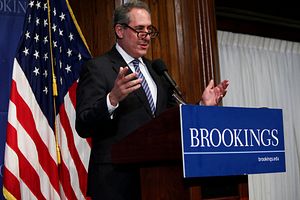One of the biggest ongoing arguments in the TPP negotiations (as far as we know, anyway) remains the question of how far the United States can push the other signatories to adopt its views on intellectual property law. The contentious points revolve around the ability to undertake criminal legal action against IP violators. “The U.S. wants the standards for damages to be very high, and to go beyond TRIPS (Trade-Related Aspects of Intellectual Property Rights) obligations for injunctions and the destruction of infringing goods,” according to James Love of Knowledge Economy International. The United States has also pushed for increasing the ability of government to undertake criminal legal procedures against intellectual property infringers.
What’s at stake? The criminalization of IP infringement in a multilateral agreement would give the United States legal teeth for enforcing its preferred system of intellectual property protection across the world.
The U.S. wants this for several reasons. First, U.S. corporate actors have long viewed intellectual property protection as a key element of their profit strategies, and believe that IP violations in many of the TPP’s candidate countries have severely cut into their margins. These firms helped build the existing architecture of the international intellectual property regime, and they clearly want to ensure that they have access to the most effective possible tools for maintaining control of their IP.
Second, it appears that the Obama administration has come to the conclusion that strict IP regulation, including protection not only of U.S. copyrights and patents, but also of U.S. trade secrets, is the key to U.S. industrial and technological competitiveness in the coming decades. Because of changes associated with the digitization of knowledge and the advent of 3D printing, the United States has concluded that traditional methods for staying on the edge of the innovation curve will not suffice. The advanced nature of the U.S. economy means that an ever-greater percentage of its products (whether artistic, commercial, or industrial) consists of intellectual property, which loses its value if not properly protected. Expanding protection world-wide for U.S. intellectual property, by this logic, helps maintain the competitiveness of the U.S. economy.
The pursuit of extra-territorial jurisdiction for U.S. law is part of an uptick in the “offensive” use of “lawfare” by the United States. The most obvious recent use of such legal tools involved the Department of Justice’s corruption indictments of numerous FIFA officials, but both the U.S. government and a variety of private individual and organizations have also taken advantage of U.S. law to pursue extra-territorial justice. Building this mechanism into the TPP makes the offensive use of lawfare easier in this regard.
China is not currently a part of TPP, and it may not become part of it in the future. However, Chinese firms and Chinese individuals regularly conduct commerce in countries that will become part of the TPP, assuming ratification. As I’ve argued previously, an expansion of the IP rules, norms, and legal sanctions preferred by the United States could have an impact on the diffusion of military technology into the Asia-Pacific. One of the key assumptions underlying “third offset” thinking in U.S. military innovation circles involves the impossibility of preventing technology diffusion in the digital age. The legal tools provided by the TPP could eventually give the United States a way of curbing that diffusion, by bringing civil and criminal action against Chinese individuals and Chinese firms suspected of violating U.S. intellectual property law, or of benefiting from the violation of such law. This won’t necessarily change the thinking of the PLA, but it might well change how Chinese scientists, engineers, and businessmen treat illicitly acquired data and technology.
The United States views TPP as a mechanism for ensuring that the rules that govern intellectual property protection around the world hew, as closely as possible, to U.S. interests. Eventually, the Justice Department may become the most critical offensive tool for maintaining U.S. technological advantage.
































